There are many places to visit in Uttar Pradesh but this article covers the best places to visit in Uttar Pradesh, which will help you to save time and get the details. Uttar Pradesh is a state which is located in North India and it shares the border with eight states and one Union Territory in India, namely Haryana, Himachal Pradesh, Uttarakhand, Bihar, Madhya Pradesh, Jharkhand, Chhattisgarh, Rajasthan, Delhi. Its offerings range from vibrant communities, a wealth of cultural heritage, magnificent monuments, and temples to the revered waters of the holy Ganga. It’s also known as the “Heartland of India,” this region boasts an array of captivating destinations that are a must-visit for any traveler.
Places To Visit In Uttar Pradesh
1. The Taj Mahal in Agra
 For those experiencing India for the first time, the iconic Taj Mahal is an irresistible must-see on any travel bucket list. It is one of the seven wonders in the world and it is one of the most popular places to visit in Uttar Pradesh in India. Agra has garnered international acclaim as a heritage hotspot, solidifying its reputation as a cultural treasure in the country. The Taj Mahal is in Agra and is situated on the banks of the River Yamuna. It is recognized as a UNESCO World Heritage Site, and the iconic Taj Mahal in Agra stands as one of the architectural marvels of the state. The mausoleum in Agra stands as India’s most renowned monument, a sublime tribute to eternal love. Constructed between the years 1632 and the year 1647 by the Mughal Emperor Shah Jahan, the Taj Mahal stands as a testament of love. It is dedicated to Shah Jahan’s beloved wife, Mumtaz Mahal, who passed away during childbirth. However, despite its iconic status, a significant portion of its history remains veiled in mystery.
For those experiencing India for the first time, the iconic Taj Mahal is an irresistible must-see on any travel bucket list. It is one of the seven wonders in the world and it is one of the most popular places to visit in Uttar Pradesh in India. Agra has garnered international acclaim as a heritage hotspot, solidifying its reputation as a cultural treasure in the country. The Taj Mahal is in Agra and is situated on the banks of the River Yamuna. It is recognized as a UNESCO World Heritage Site, and the iconic Taj Mahal in Agra stands as one of the architectural marvels of the state. The mausoleum in Agra stands as India’s most renowned monument, a sublime tribute to eternal love. Constructed between the years 1632 and the year 1647 by the Mughal Emperor Shah Jahan, the Taj Mahal stands as a testament of love. It is dedicated to Shah Jahan’s beloved wife, Mumtaz Mahal, who passed away during childbirth. However, despite its iconic status, a significant portion of its history remains veiled in mystery.
Visit Timings: 06:00 AM – 07:00 PM (However, it remains closed for prayers on Fridays)
Entry Fee: ₹ 50* for Indians, ₹ 1100* for Foreigners and Citizens of SAARC and BIMSTEC Countries ₹ 540*. +Extra charges if you are visiting the main Mausoleum (It is optional)= ₹ 200/- only.
Location: The distance from Agra Fort Railway Station to the specified location is 3 kilometers.
Trip Duration: 2-3 Hours.
Other Top Major Tourist Attractions in Agra
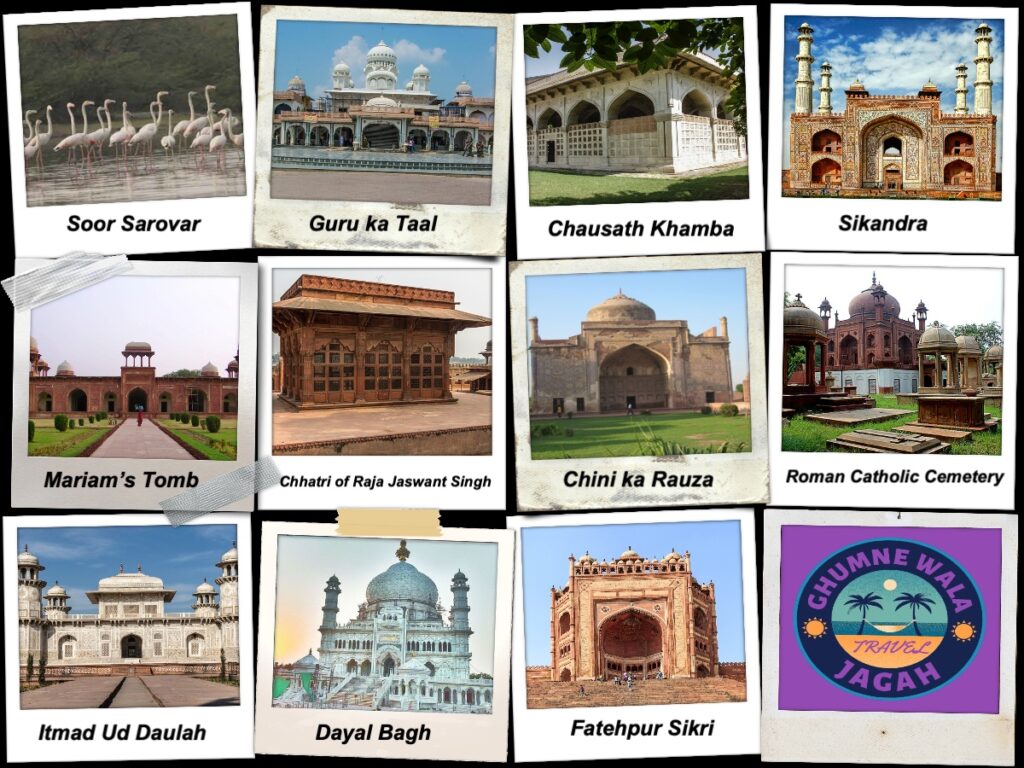
Soor Sarovar
Soor Sarovar, also known as Keetham Lake is a scenic reservoir located in Agra, Uttar Pradesh, India. A 15-acre haven comprising peaceful wetlands and hosting a diverse population of migratory and indigenous birds. It serves as a popular recreational spot and is surrounded by lush greenery, making it a tranquil destination for nature enthusiasts.
Visit Timings: 08:30 AM – 06:00 PM
Entry Fee: ₹ 30* for Indians, ₹ 350* for Foreigners
Location: Mathura Delhi Highway, Near Runakata, near Walter World.
Trip Duration: 2-3 Hours.
Guru ka Taal
Guru ka Tal is a significant Sikh pilgrimage site in Agra, devoted to the ninth Guru, Sri Guru Tegh Bahadur Ji. It is situated near Sikandra, the Gurudwara commemorates the spot where Guru Tegh Bahadur willingly submitted to arrest by Aurangzeb, the Mughal Emperor. Today, Guru ka Taal is a serene spot for reflection and prayer, drawing visitors from near and far to pay homage to the Sikh Guru.
Visit Timings: All time
Entry Fee: Free
Location: Chennai – Delhi Highway, Maharishi Puram Colony, Agra, Uttar Pradesh 282007.
Trip Duration: 30 – 40 Minutes
Chausath Khamba
Chausath Khamba, also known as the 64 Pillared Hall is a historical monument located in Agra, Uttar Pradesh. It is believed to be the tomb of Saadiq Khan’s son, Salabat Khan, a former commander under Mughal Emperor Shah Jahan. Constructed during the 17th century under the reign of Mughal Emperor Shah Jahan, Fatehpur Sikri stands as a timeless architectural marvel. The structure is characterized by its 64 pillars arranged in a grid-like pattern, supporting a large dome. Chausath Khamba is believed to have served as a guesthouse or a meeting hall during the Mughal era. Today, it stands as a significant architectural marvel and a popular tourist attraction in Agra. A visit to this beautiful site is a must for those exploring Agra’s rich historical treasures.
Entry Fee: ₹ 70*
Trip Duration: 30 Minutes.
Sikandra
Sikandra, a predominantly residential area, is famed for housing the tombs of Mughal Emperor Akbar and his wife, Mariam. The elaborate 17th-century Tomb of Akbar the Great, adorned with white marble inlays, stands at the center of an expansive Charbagh-style garden. Mariam’s Tomb, originally a 1400s pleasure pavilion, retains remnants of its original paintings. The complex encompasses beautifully landscaped gardens and intricate decorative elements, making Sikandra a significant cultural and historical attraction for visitors exploring Agra.
Visit Timings: 06:30 AM – 06:30 PM
Entry Fee: ₹ 30* for Indians, ₹ 310* for Foreigners and For Camera ₹ 25*
Location: The fort, located approximately a 30-minute drive from the Agra Cantonment Railway Station, welcomes visitors daily with its grandeur and historical significance.
Trip Duration: 30-45 Minutes
Mariam’s Tomb
The Tomb of Mariam-uz-Zamani, also known as Mariam’s Tomb. It is popularly known as Jodha Bai, who held the esteemed position of favorite wife to the Mughal Emperor Akbar. Originally built as a pleasure pavilion in the 15th century, it now serves as the final resting place for Mariam, one of Emperor Akbar’s wives. The tomb exhibits architectural beauty and retains traces of its original paintings. It is one the most famous places to visit in Uttar Pradesh. Its offers to visitors a glimpse into the artistic richness of the Mughal period.
Visit Timings: 06:00 AM – 06:00 PM
Entry Fee: ₹ 15* for Indians, ₹ 200* for Foreigners, and free for children below 15 years.
Location: Situated just 11 km away from Agra Cantonment Railway Station and a mere 1.5 km from Akbar’s Tomb.
Trip Duration: 2-3 Hours
Chhatri of Raja Jaswant Singh
It is situated around 9.5 km from Agra Cantonment Railway Station and 4 km from Itimad-ud-Daulah. Jaswant Singh ki Chhatri is located in Rajwara, Balkeshwar along the banks of the Yamuna River, is now under the maintenance of the Archaeological Survey of India. This ornate structure, adorned with intricate carvings, stands as a tribute to the valor and contributions of Raja Jaswant Singh.
Visit Timings: 06:00 AM – 06:00 PM
Location: Rajwara, Balkeshwar, Agra.
Trip Duration: 15-30 Minutes
Chini ka Rauza
Chini ka Rauza, a mausoleum in Agra, India, housing the tomb of Afzal Khan Shirazi. It is a renowned scholar and poet who served as the Grand Vizier of Mughal Emperor Shah Jahan. It was constructed in the year 1635 and stands as an exquisite example of Mughal architecture. Located on the eastern bank of the Yamuna River, Chini ka Rauza is a testament to the Mughal architectural finesse and craftsmanship. The monument is distinguished by its intricate glazed tile work, known as Chini kaari, which gives it a distinct and vibrant appearance.
Visit Timings: 06:00 AM – 06:00 PM
Entry Fee: NA
Location: Katra Wazir Khan, Agra.
Trip Duration: 45 Minutes -1 Hours
Roman Catholic Cemetery
A tranquil Christian cemetery, distinguished by Mughal-style gravesites and historic tombs, stands as a peaceful resting place in Agra.
Visit Timings: Morning to Evening
Entry Fee: NA
Location: Moti Bagh, Agra.
Trip Duration: 1 -2 Hours
Itmad Ud Daulah
The Tomb of I’timad-ud-Daulah, is a Mughal mausoleum located in Agra, Uttar Pradesh. It is commonly referred to as the “jewel box” or “Baby Taj,” and is often considered a precursor to the Taj Mahal due to its architectural similarities.
Visit Timings: Morning to Evening
Entry Fee: ₹ 30* for Indians, ₹ 310* for Foreigners, For Citizens of SAARC and BIMSTEC Countries ₹ 30* and free for children below 15 years.
Location: Moti Bagh, Agra.
Trip Duration: 1 – 2 Hours
Dayal Bagh
Dayalbagh, meaning “Garden of the Merciful,” is a district in western Uttar Pradesh, India, situated in metropolitan Agra. It is serving as the headquarters of the Dayalbagh subsect of the Radha Soami sect, where the 8th revered leader resides and presides over the Satsang.
Visit Timings: 06:00 AM – 06:30 PM
Entry Fee: NA
Fatehpur Sikri
Fatehpur Sikri is a UNESCO World Heritage Site located near Agra, Uttar Pradesh, India. It is one of the most famous places to visit in Uttar Pradesh. This historical city was founded by the Mughal Emperor Akbar in the 16th century. Designated as the “city of victory,” it was designated as the capital by the Mughal Emperor Akbar. Known for its well-preserved architecture, including the Buland Darwaza, Jama Masjid, and the Panch Mahal, Fatehpur Sikri stands as a remarkable testament to Mughal art and cultural synthesis.
Visit Timings: 06:00 AM – 06:00 PM
Entry Fee: ₹ 50* for Indians, ₹ 610* for Foreigners, For Citizens of SAARC and BIMSTEC Countries ₹ 50* and free for children below 15 years.
Location: It is 40 kms away from Agra.
Trip Duration: 2-3 Hours
How to Reach Agra?
Air: Agra’s Kheria airport, which also serves as a military base, operates as a seasonal commercial airport with limited connectivity. It is primarily serviced by Air India flights from New Delhi. The short flight from Delhi to Agra takes less than an hour, with Kheria airport located 13 kilometers from the city center. Upon arrival, travelers can easily hire a taxi for a quick 10-15 minute journey to reach the city, depending on traffic conditions.
Road: Agra enjoys excellent road connectivity with major cities such as Delhi, Jaipur, Gwalior, Lucknow, and Kanpur, with daily bus services operating between these destinations. Agra boasts two prominent interstate bus terminals, known as Idgah Bus Stand, facilitating seamless travel for commuters. The Yamuna Expressway efficiently connects Delhi to Agra, significantly reducing travel time between the two to just 2.5 hours.
Rail: For those traveling from other parts of the country besides Delhi, Mathura, Vrindavan, Noida, or Gurgaon, the most convenient mode of transportation to Agra is by train. Agra features five railway stations, including Agra Cantt Station (the primary station), Agra Fort Railway Station, Raja ki Mandi, Agra City, and Idgah Railway Station. The Taj Mahal and Agra Fort are conveniently located near Agra Cantt railway station, where visitors can easily hire pre-paid taxis, auto-rickshaws, or cycle rickshaws to reach these iconic attractions.
2. Spiritual City Varanasi
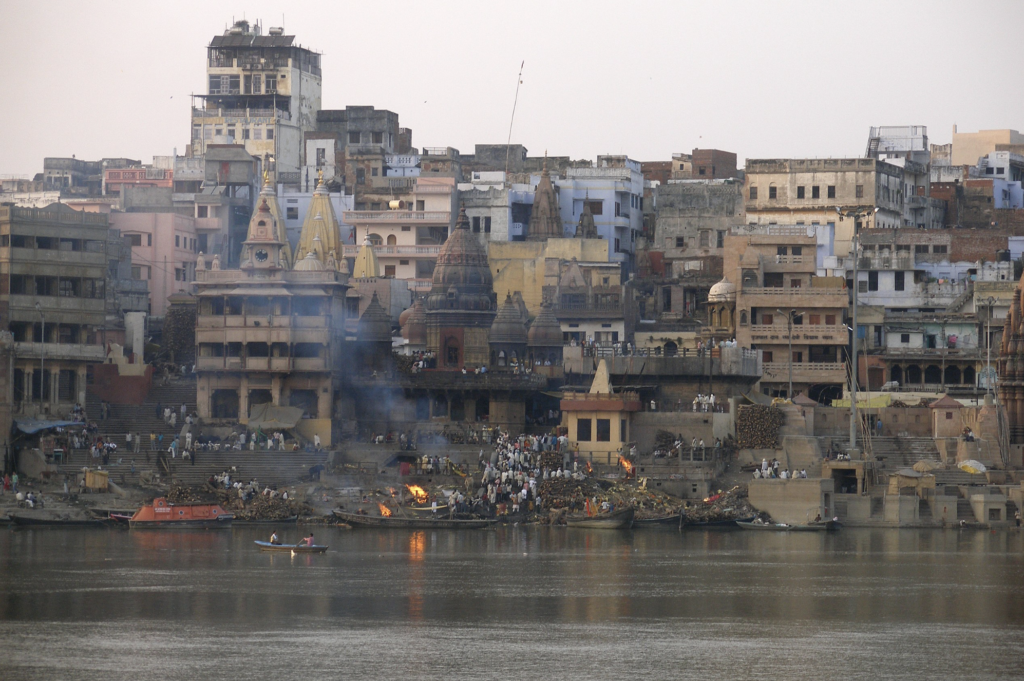
Regarded as one of the oldest continually inhabited places globally, this religious city in Uttar Pradesh holds a rich historical and cultural legacy. It is one of the most famous places to visit in Uttar Pradesh. Nestled along the banks of the River Ganges, Varanasi is renowned for its ghats and meandering lanes adorned with temples of various sizes and architectural styles. Varanasi, is a city in the northern Indian state of Uttar Pradesh with roots dating back to the 11th century B.C. It is often hailed as the spiritual capital of India. A haven for devotees of Shiva and a residence for some uniquely attired sadhus, Varanasi is a city that embraces spiritual diversity and eccentricity. The city attracts Hindu pilgrims who engage in ritualistic bathing in the sacred waters of the Ganges River and participate in funeral rites along its revered ghats. Nestled along the city’s labyrinthine streets are approximately 2,000 temples, among them the renowned Kashi Vishwanath, known as the “Golden Temple,” dedicated to the Hindu deity Shiva. Visitors are encouraged to witness the mesmerizing Arati ceremony at Dashashwamedh Ghat, a traditional and captivating ritual conducted every evening along the sacred banks of the Ganges River. Varanasi is renowned across India for its exquisite production of fine silk and Banarasi saris, adorned with intricate brocades featuring gold and silver threadwork, making them highly coveted for weddings and special occasions.
Top Major Tourist Attractions in Varanasi
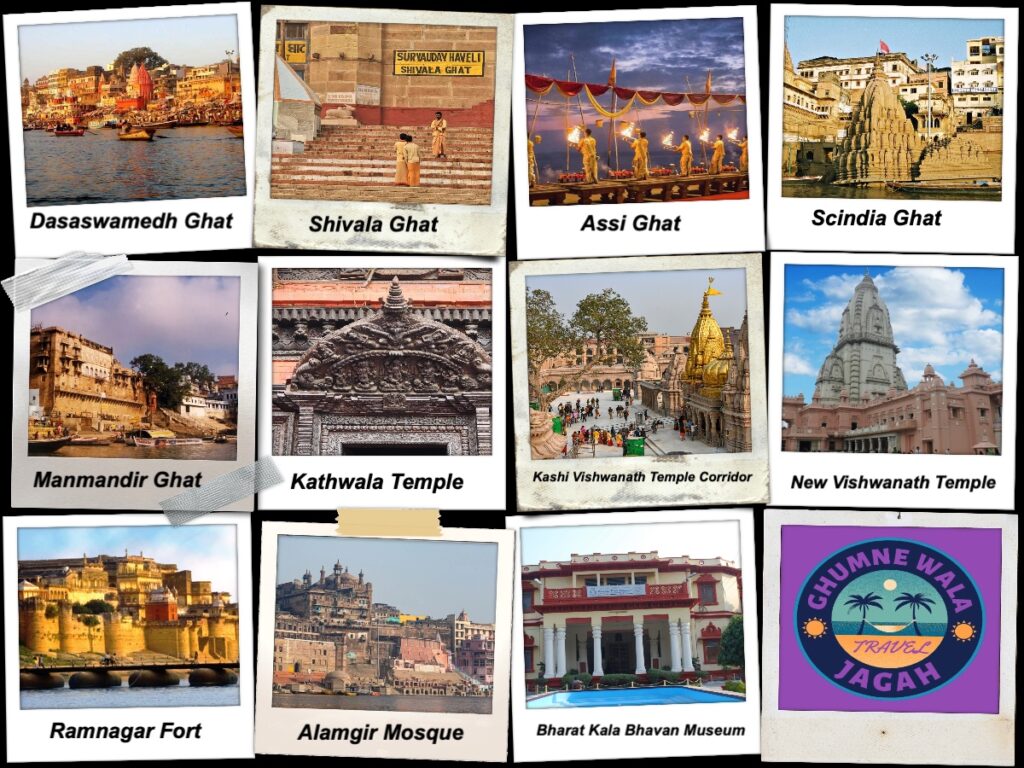
Dasaswamedh Ghat
It is one of the most famous places to visit in Uttar Pradesh. Dashashwamedh Ghat, situated on the banks of the Ganges River in Varanasi, Uttar Pradesh, is a prominent ghat located near the Vishwanath Temple. This ghat holds significance in Hindu mythology, with two legends associated with its creation: one attributing it to Brahma’s welcome of Shiva, and another involving Brahma’s performance of the Dasa-Ashwamedha Yajna, or the ten Ashwamedha sacrifices.
Shivala Ghat
Shivala Ghat, one of the largest ghats in Varanasi, India. Its stands as a testament to devotion, having been constructed by King Balwant Singh in honor of the Hindu god Shiva.
Assi Ghat
The location is notably secure and less bustling than other areas along the ghats, offering the convenience of witnessing both morning and evening aartis right at your doorstep, with the option to take a boat for sunrise or attend ceremonies at other ghats. The area also features numerous restaurants and is easily accessible by rickshaw.
Scindia Ghat
Scindia Ghat, positioned along the Ganges in Varanasi, shares its border with Manikarnika Ghat, the sacred Hindu cremation site, to the north. Notably, a tilting Shiva temple partially submerged in the Ganges can be observed at this ghat, sparking debates about its collapse due to its own excessive weight.
Manmandir Ghat
Man Mandir Ghat, located north of Dashashwamedh Ghat in Varanasi, is not only expansive but also aesthetically captivating. It is also known as Someswara Ghat. It is home to the lingam of Lord Someshwar (another form of Lord Shiva). It was constructed in 1600 AD by Maharaja Man Singh of Amer. The ghat is accompanied by a magnificent palace, renowned for its elaborate window carvings and other splendid features, making it a notable tourist attraction. The Man Mandir Ghat is adorned with several Hindu temples, such as Rameshwara Temple, Sthuladanta Vinayak Temple, and Someshwara Temple, enhancing its cultural significance. The ghat exudes a unique charm during evenings and early mornings, attracting visitors who can be seen unwinding and savoring the picturesque views it offers.
Kathwala Temple
Kathwala Nepali Mandir, situated on Lalita Ghat in Varanasi, is approximately 3.8 kilometers southeast of Varanasi Junction railway station. Built by the Nepalese Shah king Rana Bahadur Shah during his exile, the Nepali Mandir features distinctive Nepali-style architecture that sets it apart from other temples in the area.
Kashi Vishwanath Temple Corridor
The Kashi Vishwanath Corridor aims to streamline the journey between the temple and the Ganges River, providing a more accessible route and alleviating congestion by creating additional space.
New Vishwanath Temple
The Kashi Vishwanath Temple is situated in Vishwanath Gali, Varanasi in Uttar Pradesh. It is a sacred Hindu shrine dedicated to Shiva and holds significance as one of the twelve Jyotirlinga pilgrimage sites.
Ramnagar Fort
The Ramnagar Fort is an impressive sandstone structure built in the Mughal style in 1750 by Kashi Naresh Maharaja Balwant Singh. It stands as a fortified landmark in Ramnagar, Varanasi, India, situated along the eastern bank of the Ganges River, opposite the Tulsi Ghat.
Alamgir Mosque
The Alamgir Mosque, also known as Aurangzeb’s Mosque, is a historic mosque located in Varanasi, Uttar Pradesh, India. It is one of the most famous places to visit in Uttar Pradesh.
Bharat Kala Bhavan Museum
Bharat Kala Bhavan is situated in Banaras Hindu University, Varanasi, India. It serves as a significant university museum that has played a crucial role in sharing knowledge about Indian art and culture. It stands as a noteworthy tourist attraction within Banaras Hindu University and the city of Varanasi.
How to Reach Varanasi?
Varanasi is a well-connected city in India. It boasts an airport with flights to major cities. Here a railway station is linked to numerous destinations nationwide. It is well connected to a reliable road transport network.
3. Vrindavan
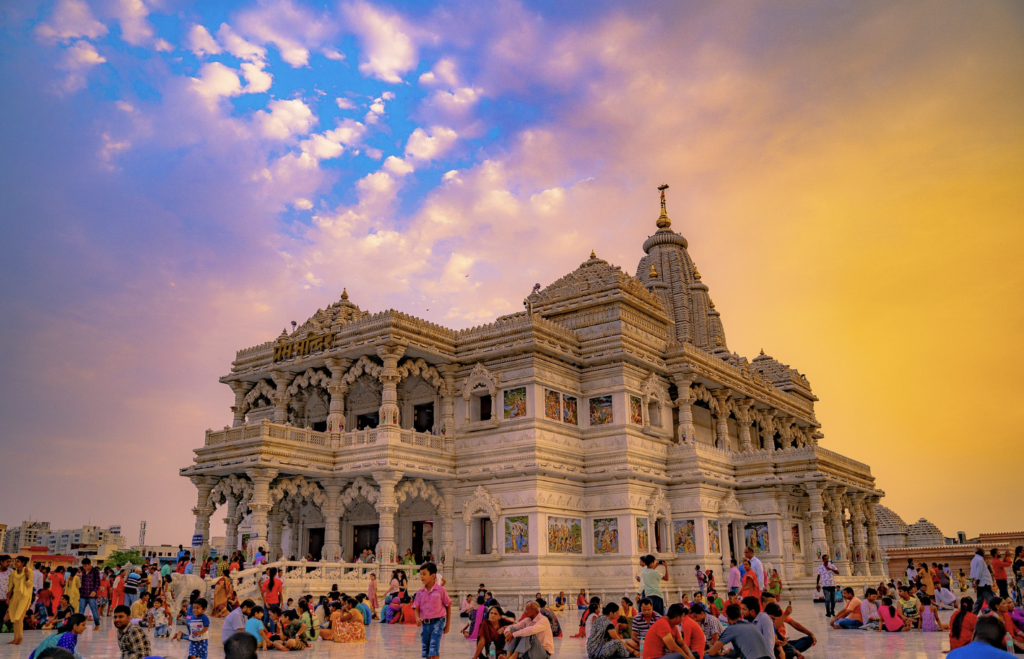
Vrindavan is located in Uttar Pradesh, northern India. It is one of the most famous places to visit in Uttar Pradesh. It is a sacred town where the Hindu deity Krishna is believed to have spent his childhood. Abounding in temples, many dedicated to Krishna and his beloved Radha. Notable sites include the Banke Bihari Temple, where the curtain in front of Krishna’s statue is ritually opened and closed. Radha Raman Temple features a gold plate beside Krishna symbolizing Radha, and the grand white marble Prem Mandir. Vrindavan holds immense religious significance for Hindu devotees. Its attracting worshippers of Lord Krishna who flock to seek blessings in this sacred place. Dozens of temples, ranging from ancient to modern, adorn the town of Vrindavan. Narrow winding lanes, lined with shops selling worship items and sweets, provide access to each temple in Vrindavan. It enhances the spiritual and sensory experience of visitors. Visitors should be cautious of monkeys, known for their bold behavior in practically mugging tourists. Exploring Uttar Pradesh would be incomplete without experiencing the spiritual charm of Vrindavan.
Top Major Tourist Attractions in Vrindavan
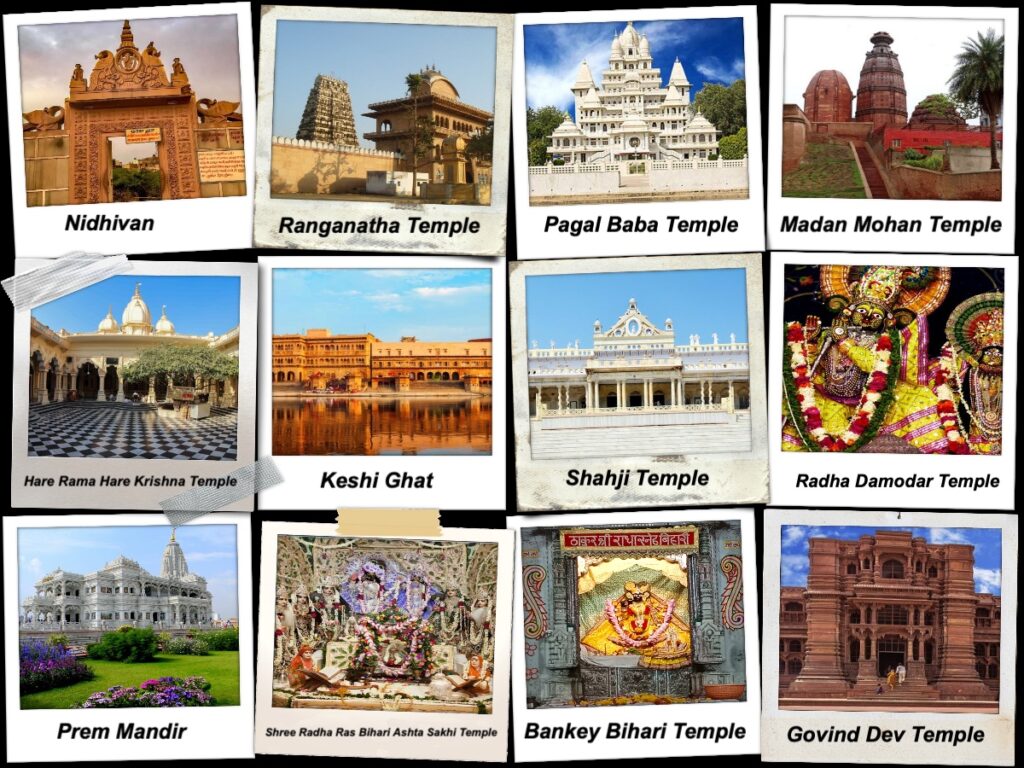
Nidhivan
Nidhivan, shrouded in mystery, is a captivating place in Vrindavan, characterized by a dense forest adorned with lush green Tulasi trees, revered as holy plants. It is revered as the foremost site dedicated to the divine pastimes of Hindu deities Radha and Krishna, along with their beloved cowherd companions, the Gopikas.
Ranganatha Temple
The temple is devoted to Lord Sri Goda Ranagamannar, a revered South Indian Vaishnava Saint, and Lord Ranganatha, an incarnation of Lord Krishna, adding to its religious significance. The focal point of the temple is the idol of Krishna depicted as the groom alongside Goda (Andal) as his bride, symbolizing their divine union and eternal love.
Pagal Baba Temple
Pagal Baba Ashram, was built by Pagal Baba (Shri Leelanand Thakur), formerly a judge, affectionately referred to as “Pagal Baba” (Mad Baba) by devotees.
Madan Mohan Temple
Shri Radha Madan Mohan Temple, located in Vrindavan, Uttar Pradesh, stands as one of the oldest and most revered Hindu temples in the region, holding deep religious significance. It is constructed in the Nagara style of architecture. The Radha Madan Mohan Temple stands majestically on the bank of the Yamuna River, reaching a height of 50 feet near Kaliya Ghat, making it one of the most renowned Goswami shrines in Uttar Pradesh.
Hare Rama Hare Krishna Temple
Experience a profound sense of divinity and immerse yourself in the love of Lord Krishna at ISKCON, where the atmosphere exudes unique vibes, whether it’s day or night.
Keshi Ghat
Keshi ghat is the primary ghat of Vrindavan and it holds immense religious importance as one of the significant worshiping places in the city. It is serving as a visible remnant of the ghat tradition in Vrindavan. Constructed by Queen Laxmi Devi of Bharatpur in the late 17th century, it showcases distinctive Rajasthani architectural style.
Shahji Temple
The 19th-century Hindu temple is characterized by its twisted marble pillars and a magnificent hall adorned with Belgian chandeliers, adding to its architectural grandeur and historical significance.
Radha Damodar Temple
Shri Radha Damodar Temple is located in Vrindavan, Uttar Pradesh. It is a Hindu temple devoted to the worship of the revered deities Radha and Krishna. Constructed in the 1540s, this Hindu temple is dedicated to Radha Damodara and holds a relic believed to be Krishna’s footprint, adding to its spiritual significance and attracting devotees from far and wide.
Prem Mandir
Prem Mandir is a Hindu temple situated in Vrindavan, Mathura district, Uttar Pradesh, India. It was founded by Jagadguru Shri Kripalu Ji Maharaj and is currently overseen by Jagadguru Kripalu Parishat. It is a global non-profit organization dedicated to education, spirituality, and charitable activities.
Shree Radha Ras Bihari Ashta Sakhi Temple
A must-visit for devotees of Lord Krishna and those who have completed the 84 Kosh Vraj Parikrama Yatra. This ancient temple holds significant reverence in the hearts of pilgrims.
Bankey Bihari Temple
The Banke Bihari Temple is located in the town of Vrindavan, Mathura district, Uttar Pradesh. It is dedicated to Banke Bihari, believed to embody the divine union of Radha and Krishna, originally worshipped at Nidhivan in Vrindavan.
Govind Dev Temple
Govind Dev Temple is a highly revered holy site in Vrindavan. It is distinguished by its unique architecture and was built in 1590 by King Man Singh of Amer at a cost of ten million rupees. Despite being plundered during Aurangzeb’s reign in 1670, the three-storied structure of the temple still stands as a testament to its historical significance. The major allure of Govind Dev Ji Temple in Vrindavan lies in its magnificent architecture, crafted nearly 500 years ago from red sandstone, showcasing timeless beauty and historical splendor.
How to Reach Vrindavan?
The most convenient mode of transportation to Vrindavan is by train, with regular services connecting to Delhi, Jaipur, Nagpur, Pune, and Bangalore. Alternatively, driving from Delhi, Agra, and Mathura is considered ideal for reaching Vrindavan.
4. Ayodhya
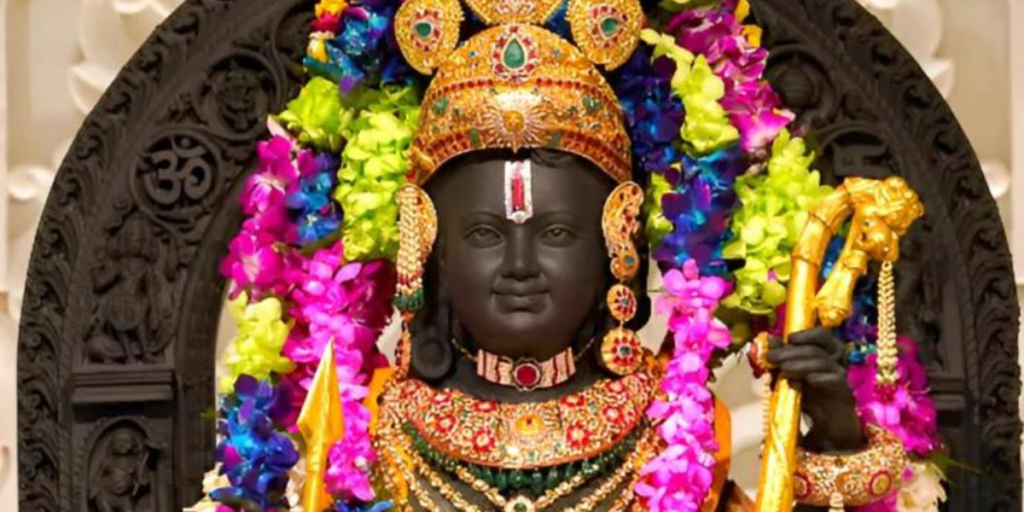
Located on the banks of the Sarayu River in the Indian state of Uttar Pradesh, Ayodhya, previously known as Saketa, serves as the administrative headquarters for both the Ayodhya district and the Ayodhya division. Ayodhya offers a profound spiritual experience with its plethora of temples, making it an ideal destination for a temple tour in Uttar Pradesh. It is one of the most famous places to visit in Uttar Pradesh. The main attraction is in Ayodhya is Ramlalla Temple which is recently constructed and opened for all now to Ramlalla Darshan.
Other Major attraction

How to Reach Ayodhya?
The most convenient way to reach Ayodhya is by train, with regular services connecting to Kolkata, Jaipur, Delhi, Lucknow, and other smaller cities. Alternatively, Ayodhya is well-connected by road, with Lucknow at 130 km, Allahabad at 155 km, and Varanasi at 200 km, offering the option of driving to the city.
To Read the Full Article about Ayodhya please click here: Read More about Ayodhya..
5. Prayagraj

Prayagraj is renowned for its Sangam, the sacred confluence of rivers, and hosts the Kumbh Mela, one of the largest and holiest gatherings in Hinduism. Prayagraj is one of the most tourist attractions places to visit in Uttar Pradesh. Prayagraj holds a significant place in Indian history and has been the residence of notable figures such as Jawaharlal Nehru and Harivansh Rai Bachchan, contributing to its cultural and historical prominence. Prayagraj is known for its British-era architecture, Mughal forts and tombs, and its unique “red” guavas, adding to the city’s charm and distinctiveness.
Top Major Tourist Attractions in Prayagraj
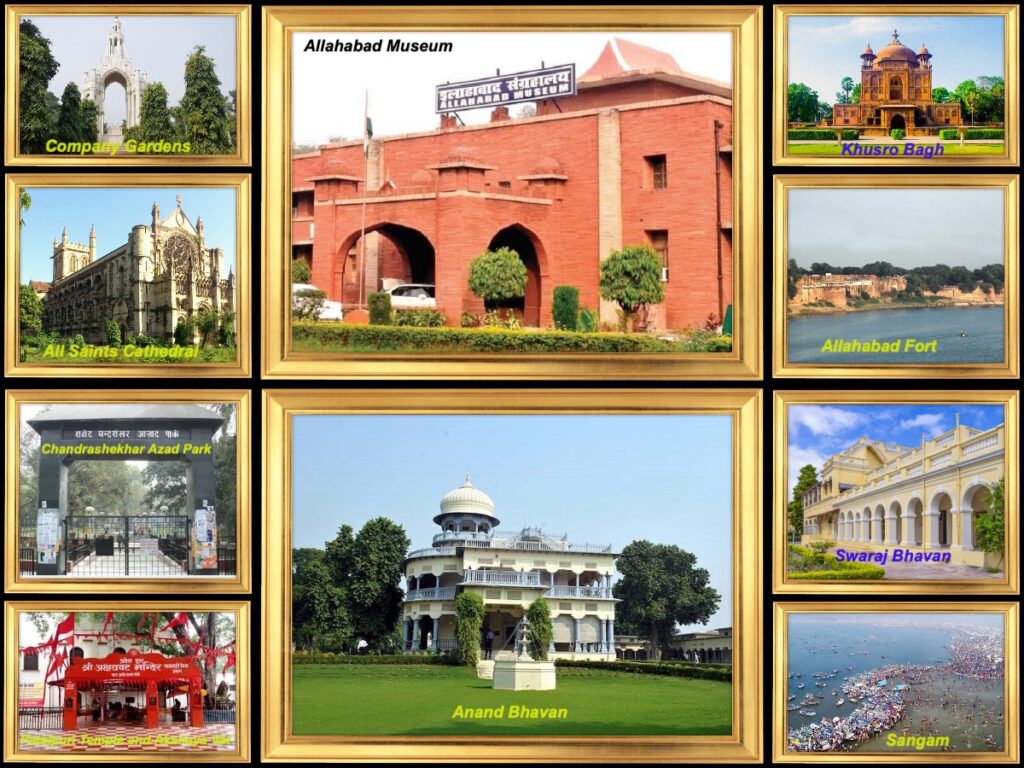
Company Gardens
Chandra Shekhar Azad Park, formerly known as Alfred Park and Company Bagh. It is a sprawling public park located in Prayagraj, Uttar Pradesh, India. Spanning over 133 acres, it was established in 1870 to commemorate Prince Alfred’s visit to the city, making it the largest park in Prayagraj.
Allahabad Museum
Established in 1931 and funded by the Ministry of Culture, the Allahabad Museum in Prayagraj, Uttar Pradesh. It stands as a national-level institution renowned for its extensive collection of unique art objects, showcasing a treasure trove of cultural heritage. It is one of the famous places to visit in Uttar Pradesh.
Khusro Bagh
Khusro Bagh is an expansive walled garden and burial complex situated in the Khuldabad neighborhood near Prayagraj Junction railway station, Prayagraj. It is approximately 6 km from the Akbar Fort, spans over 40 acres, and takes the shape of a quadrangle.
All Saints Cathedral
All Saints’ Cathedral fondly referred to as Patthar Girja, stands as a prominent United Protestant cathedral nestled in Prayagraj, India, affiliated with the Church of North India. Modeled after 13th-century Gothic-style churches. It stands as a testament to the Gothic Revival architecture embraced by the British during their colonial era in India.
Allahabad Fort
The colossal fort constructed by Emperor Akbar in the year 1583 graces the banks of the Yamuna, near the confluence site. Renowned for its unparalleled design, construction, and craftsmanship, the massive fort boasts three splendid galleries adorned by lofty towers, reflecting its historical grandeur.
Chandrashekhar Azad Park
In commemoration of Prince Alfred of Saxe-Coburg and Gotha’s visit to Prayagraj (previously known as Allahabad) in 1870. It is a sprawling 133-acre park that was established in the heart of the city’s English quarters, Civil Lines. In 1931, the iconic Alfred Park became the site of a fierce gunfight between the British and Chandra Shekhar Azad, a revolutionary freedom fighter. At the age of 24, Azad tragically lost his life here on 27 February 1931, leaving an indelible mark on the park’s historical significance.
Anand Bhavan
Anand Bhavan is a historical house museum in Prayagraj, India. It is dedicated to the Nehru family, offering insights into their lives and serving as a significant repository of historical artifacts and memorabilia. It is acquired by Indian political leader Motilal Nehru in the 1930s. It was intended to serve as the residence of the Nehru family after the original mansion, Swaraj Bhavan (formerly known as Anand Bhavan), was repurposed as the local headquarters of the Indian National Congress. In 1970, the residence was generously donated to the Indian government by the then Prime Minister of India, Indira Gandhi, showcasing a commitment to preserving and sharing the historical legacy of the Nehru family.
Swaraj Bhavan
Swaraj Bhavan is a spacious mansion in Prayagraj, India. It’s renowned for its association with Indian political leader Motilal Nehru and as the former residence of the Nehru family until the year 1930. It is now operated by the ‘Jawaharlal Nehru Memorial Fund’ as a public museum.
Patalpuri Temple and Akshaya Vat
It is situated on the outskirts of Prayagraj. the Patalpuri Temple stands as a prominent spiritual destination, characterized by its unique underground shrine hosting idols of various Hindu deities. The temple’s highlight is the Akshaya Vat, an immortal banyan tree, that adds to its sacred ambiance.
Sangam
Triveni Sangam is the sacred meeting point of the Ganges (Ganga), the Yamuna, and the legendary Saraswati River, forming a revered confluence in Hindu tradition. According to Hindu tradition, Triveni Sangam is considered the auspicious confluence of three rivers. It is a sacred site where a bath is believed to cleanse one of the sins and liberate from the cycle of rebirth. Apart from its religious significance, Triveni Sangam serves as a site for the historic Kumbh Mela held every 12 years. Triveni Sangam has been witness to the immersion of the ashes of Mahatma Gandhi in 1949, contributing to the historical richness and cultural significance of the site. It is one of the most famous places to visit in Uttar Pradesh.
How to Reach Prayagraj?
Prayagraj is extensively connected to major cities across India by train, making it the ideal mode of transportation to reach the city. It is also well connected to the road.
6. Mathura
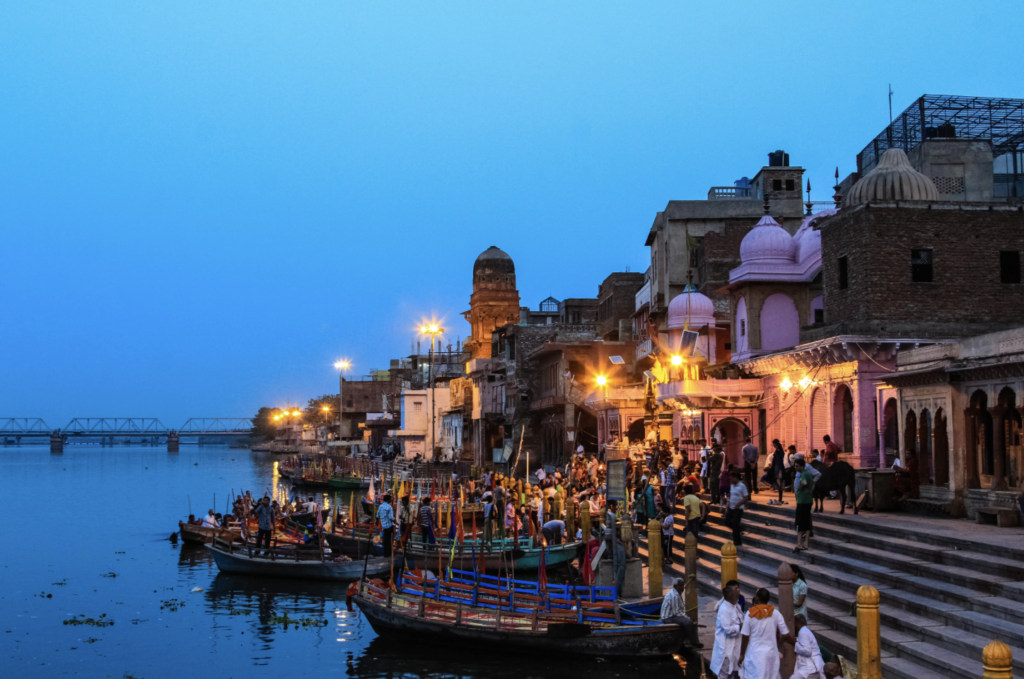
Mathura is located in the northern part of Uttar Pradesh, India. It is one of the most famous places to visit in Uttar Pradesh due to holds spiritual significance as the birthplace of Lord Krishna at Sri Krishna Janma Bhoomi temple. It is surrounded by 25 ghats along the Yamuna River, with Vishram Ghat revered as the holiest. The city also features the 16th-century memorial tower, Sati Burj, and the intricately carved Dwarkadhish Temple housing a black-marble idol of Lord Krishna.
Top Major Tourist Attractions in Mathura
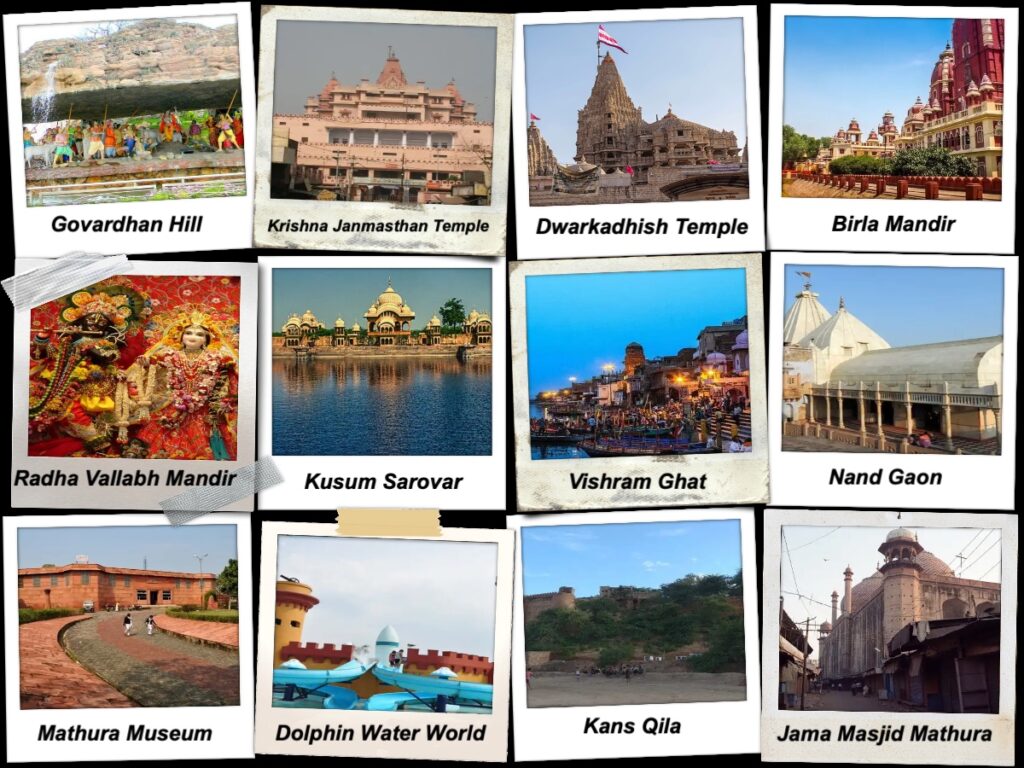
Govardhan Hill
Mount Govardhana, alternatively known as Govardhan Hill or Giriraj. Its stands as a sacred Hindu site in the Mathura district of Uttar Pradesh, India, extending over 8 km in the region of Govardhan and Radha Kund, approximately 21 kilometers away from Vrindavan. In a legendary account from history, Lord Krishna is said to have lifted the Govardhan Hill with a single finger during his youth, shielding the village of Mathura from a severe rainstorm and thunderous elements.
Krishna Janmabhoomi Temple
The Krishna Janmasthan Temple Complex is located in Mathura, Uttar Pradesh. It is one of the most famous places to visit in Uttar Pradesh. It comprises three key temples: the Keshavdev temple dedicated to Krishna, the Garbh Griha where Krishna is believed to have been born in Dvapar Yuga, and the Bhagvata Bhavan where the presiding deities are Radha Krishna. It is constructed around the prison cell where the family of Lord Krishna, including Mata Devaki and Vasudeva, were imprisoned by his wicked uncle (Mama) Kansa, the Krishna Janmasthan Temple Complex holds immense significance for Hindus as it is considered to be the birthplace of Lord Krishna. Having been repeatedly destroyed by various kings throughout history, the Krishna Janmasthan Temple was ultimately reconstructed with financial support from industrialists. The temple becomes particularly alluring during festive occasions such as Janmashtami, Basant Panchami, Holi, and Deepawali, celebrated with fervor and enthusiasm.
Dwarkadhish Temple
Its renowned worldwide for its intricate architecture and paintings, the Dwarkadhish Temple, constructed in 1814, stands as a relatively new yet highly esteemed religious edifice situated within the sacred precincts near the Ghats of the Yamuna River in Mathura. It is one of the most famous places to visit in Uttar Pradesh. It is a historic Hindu temple where Krishna is revered in his Dwarkanath or Dwarkadhish form.
Birla Mandir
It is located approximately 6.5 km from Mathura Junction along the Mathura-Vrindavan Road. The serene Birla Mandir, also known as Gita Mandir. It is a sacred abode dedicated to Lord Lakshmi Narayan, boasting remarkable architecture adorned with exquisite carvings and paintings that showcase its magnificence with pride. Notably, the Birla Mandir features the inscription of all 18 chapters of the Bhagavad Gita on its pillars, adding a profound spiritual dimension to its architectural splendor.
Radha Vallabh Mandir
It is situated near Gautam Nagar on the periphery of the Bankey Bihari temple. Radha Vallabh Mandir is one of the seven temples dedicated to the Thakur of Vrindavan, embodying the profound spiritual devotion of Radha and Krishna in the unique form of ‘Ras-bhakti’. Notably, this temple, believed to be created by Lord Krishna, exclusively venerates Krishna without a deity for Radha. It is one of the famous places to visit in Uttar Pradesh due to with its stunning architecture and exquisite decor, Radha Vallabh Mandir distinguishes itself as a captivating and aesthetically remarkable spiritual edifice.
Kusum Sarovar
Kusum Sarovar, a picturesque reservoir constructed with sandstone and a genuine relic of a bygone era, features a descending flight of stairs into the pond. Its name, according to folklore, is derived from Radha’s dasi named Kusum. The site serves as an ideal location for refreshing dips during the summer months.
Vishram Ghat
One of Mathura’s most captivating sightseeing spots, is Vishram Ghat. It is situated on the sacred banks of the River Yamuna, approximately 5 km from the city center. It serves as the focal point for 25 ghats. Pilgrims often undertake a parikrama around the ghat, which translates to a place of relaxation, as it is believed that Lord Krishna rested here after vanquishing the evil demon, Kansa. The ghat witnesses a bustling crowd during Bhaidooj for the auspicious holy dip, and visitors can also enjoy boat rides along the ghat.
Nand Gaon
NandGaon, a charming town located around 50 km from Mathura in the Nandishwara Hills, serves as the residence of Krishna’s adopted parents, Nand Ji and Yashoda Maiyya. Atop the hill, numerous temples such as Nritya Gopal, Nand Nandan, Udhav Kyaro, and Gopinath attract pilgrims and visitors alike. Additionally, the picturesque Pan Sarovar lake in NandGaon is a beloved destination among tourists, enhancing its status as one of the noteworthy attractions in Mathura.
Mathura Museum
Formerly recognized as the Curzon Museum of Archaeology, the Government Museum in Mathura. It is located at Dampier Park, is affectionately referred to by locals as the Mathura Museum. It is renowned nationwide for its extensive assortment of ancient relics, sculptures, coins, and paintings. Its esteemed for not only its historical artifacts but also its showcasing of discoveries made by renowned archaeologists in and around Mathura, it stands as one of the most revered destinations in the city.
Dolphin Water World
Dolphin Water World is spread over 14 acres of land and features exhilarating slides and roller coasters. It is a highly enjoyable attraction in Mathura. It has offered a delightful experience for visitors since its inauguration in 2002. It’s equipped with a dedicated play area for children, locker room facilities, and age-appropriate rides for all. It has become a beloved recreational center for both tourists and locals alike.
Kans Qila
It is situated along the serene banks of the Yamuna River, the magnificent Kans Qila. It is an ancient fortress dedicated to Lord Krishna’s maternal uncle, Kans. It stands as one of the most captivating nighttime destinations in Mathura. Positioned near the Krishna Ganga Ghat and Gau Ghat, this grand fort boasts a unique Hindu-Muslim fusion architecture that entices a multitude of travelers every month. Despite its current dilapidated state, drawing history enthusiasts and architecture aficionados nationwide and significantly contributing to tourism in Mathura with its rich history and undeniable charm.
Jama Masjid Mathura
It is constructed in the 17th century. The Jama Mosque stands as a significant congregational mosque in Mathura, Uttar Pradesh, India. It was commissioned by Abd-al-Nabi Khan, the governor of Mathura, during the reign of Mughal Emperor Aurangzeb.
Radha Kund
Nestled near Govardhan Hill in Mathura, Radha Kund is among the city’s foremost tourist attractions. It is renowned for its pristine and holy water, believed to possess magical healing properties, thus rendering it a significant pilgrimage site. Steeped in history dating back to the era of Krishna and Radha, Radha Kund symbolizes their eternal love and devotion.
Barsana
Barsana, a town located 21 kilometers north of Govardhan in Mathura, Uttar Pradesh, is the birthplace of Radha Rani. Radha, the beloved consort of Lord Krishna, was born in this sacred city. Barsana is renowned not only for its historical and religious significance but also for the grand celebration of Holi, known as the Lathmar Holi. During this festive occasion, locals engage in playful and colorful festivities, making it a unique and vibrant experience.
Interestingly, there are many symbolic markings on Radha’s lotus feet. One of these markings, the Trishul, signifies that all divine energy resides within her feet. While Krishna is the supreme controller, it is Sri Radha who holds sway over Krishna himself. The spiritual aura of Barsana continues to draw devotees and seekers from far and wide, seeking a glimpse of the divine love that blossomed here.🌸🙏
How to Reach Mathura?
Air: For convenient access to the region, Kheria Airport (AGR) in Agra, Uttar Pradesh, situated just 46 km away from Mathura, serves as a viable alternative with regular flight services. Indira Gandhi International Airport (DEL) in New Delhi, Delhi, located 136 km away from Mathura. It offers another major airport option for travelers seeking access to the region.
Rail: Mathura is well-connected by regular train services from major cities across the country, with two prominent railway stations, namely Mathura Junction (MTJ) and Mathura Cantt. (MRT), facilitating convenient transportation options for passengers.
Road: Mathura boasts excellent connectivity to other major cities across the country through its well-established network of regular bus services, operating from the central bus station in Mathura. You can drive from your nearest city to Mathura.
7. Lucknow
Serving as the capital of Uttar Pradesh, Lucknow stands as a sprawling metropolis situated along the picturesque banks of the Gomti River. During the 18th-century Mughal rule, Lucknow rose to prominence and experienced flourishing growth under the reign of the Nawabs. It is Known as the “City of Nawabs,” Lucknow is renowned for its literary heritage, vibrant culture, and majestic architecture. Read More..
8. Jhansi
Jhansi, formerly known as Balwant Nagar, is a historically significant city located in the Bundelkhand region of Uttar Pradesh, situated along the banks of the Pahuj River. It serves as the administrative center for both the Jhansi district and the division. It’s renowned not only for its association with “Rani Lakshmi Bai” but also for a myriad of other attractions that draw visitors to explore the city’s rich historical and cultural heritage. Read More..
Things to do in Uttar Pradesh
- Experience the rich diversity of Indian cuisines by indulging in various regional dishes, each offering a unique blend of flavors and spices.
- Embark on exhilarating wildlife safaris to explore the diverse ecosystems and observe majestic creatures in their natural habitats.
- Engage in the serene experience of boating along the Ganga Ghats and witness the enchanting evening Aartis, immersing yourself in the spiritual ambiance of the sacred river.
- Embark on a captivating heritage sightseeing tour, delving into the rich history and cultural heritage of India’s iconic landmarks and ancient monuments.
- Embark on enlightening temple tours, exploring the sacred architecture and spiritual significance of India’s diverse and revered temples.
Useful Tips

Extra Note: If you are hiring a guide, hire a reputable guide because some people face issues with the guide, they are misguiding people demanding more money, and making people fools. So be careful when hiring a Guide. If you feel unsafe, you can contact Uttar Pradesh Police by dialing 100 for help.
Conclusion
This multifaceted land, Uttar Pradesh, promises an unforgettable tapestry of history, culture, and spiritual wonder, leaving an indelible mark on every explorer.
FQAs:
Question. What is the height of the idol of Shri Ram in Ayodhya?
Answer: The idol of Lord Ram in Ayodhya’s Ram Mandir stands at 51 inches tall, symbolizing the approximate height of a 5-year-old, and is adorned with a gold bow and arrow in his hands, representing his divine attributes.
Question. Which are the best months to explore Uttar Pradesh?
Answer: September to December is the best time to visit in Uttar Pradesh.
Question. Which are some traditional foods of Uttar Pradesh?
Answer: Indulge in the culinary delights of Uttar Pradesh with a feast of regional specialties like Baati Chokha, Bedhai, Pedha, Tehri, Petha, Baigan Ki Longe, Galouti Kebabs, and Bhindi Ka Salan, readily available at numerous restaurants across the state.
Question. What are the timings of Dwarkadhish Temple?
Answer: The temple is open for visitors during the summer from 6:30 am to 10:30 am and 4:00 pm to 7:00 pm, while in the winter season, the visiting hours are from 6:30 am to 10:30 am and 3:30 pm to 6:00 pm.
Question. What are some good vegetarian vegan food restaurants in Mathura?
Answer: Flowers Rooftop Cafe, Govinda’s Restaurant, Dasaprakash, MVT Restaurant, Bansal Foods, and more stand out as some of the finest dining establishments in Mathura, providing a delightful culinary experience.
Question. What places can be covered near the Mathura Vrindavan destination?
Answer: Near Mathura and Vrindavan, travelers can explore various attractions, including the iconic Taj Mahal, the historical Agra Fort, the avian paradise of Bharatpur, a Delhi trip encompassing Akshardham, and the World Heritage Site of Fatehpur Sikri.
Question. What are the best outdoor activities in Mathura?
Answer: Engaging in the Govardhan Parikrama, exploring Kusum Sarovar Lake, and savoring the local cuisine are among the top outdoor activities that visitors can enjoy in Mathura.